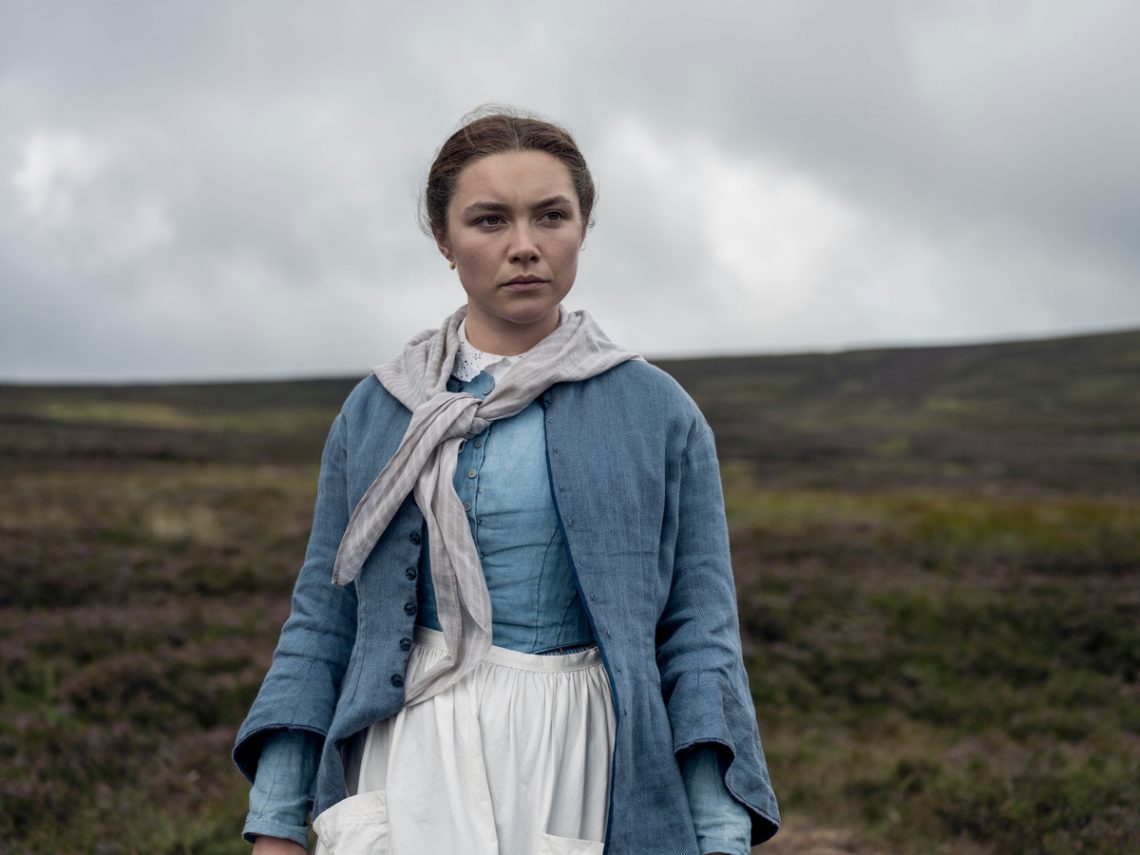Netflix’s latest period drama, The Wonder, follows Florence Pugh’s investigation into a girl, Anna, played by Kíla Lord Cassidy, who claims she does not need food to survive. Pugh’s Lib is sent to the Irish Midlands to observe the mysterious events, finding that Anna only needs “manna from Heaven” to keep her nourished and alive. Sebastián Lelio directed The Wonder and worked on the original screenplay written by Emma Donoghue.
Pugh leads an ensemble cast including Tom Burke, Niamh Algar, Elaine Cassidy, Dermot Crowley, Brían F. O’Byrne, David Wilmot, Ruth Bradley, Caolán Byrne, Josie Walker, Ciarán Hinds, and Toby Jones. Despite being labelled a period drama, prompting audience expectations based on cliches, Lelio exemplifies some innovation as a filmmaker by incorporating inventive concepts to divert these assumptions. The director wastes no time in doing so, as shown in a modern-day studio being the setting for the opening, something unexpected for a period piece.
The opening features actor Niamh Algar, who plays Kitty the servant, informing the audience that this is “The beginning of a film called The Wonder. The people you are about to meet, the characters, believe in their stories with complete devotion. We are nothing without stories. And so we invite you to believe in this one.”. This introduction was a hit or miss with audiences upon initial viewings, with some feeling it was out of place and illogical.
Lelio responded to this divide: “I thought it was important for the film itself to say to the viewer, ‘Listen, you will be exposed to the power of fiction, your disbelief will be suspended. And then you will be kindly reminded that you have been, hopefully, fervently believing in the film, in the same way in which the characters are believing their own stories.'”
“It is a film also about the collision between reason and magical thinking or science, and extreme religiousness; between spiritual and intellectual elasticity versus fanaticism,” the director also shared. “In that sense, this little framing is saying to the viewer, ‘What do you believe in? Are you fixed in your position? Or are you willing to change, adapt, and evolve? What sort of viewer are you?'”
In between this modern-day opening and then another modern-day closing, The Wonder’s runtime is littered with fourth-wall breaks as provided by Kitty, again showing Lelio’s experimental vision in genre filmmaking. Lib and Anna are the main focus of Donoghue’s story, as Lib does all she can to get to the bottom of Anna’s unexplainable circumstances.
As expected and fulfilled, the audience, alongside Lib, finds out everything towards the film’s ending. Lib, characterised by a scientific and objective manner of thinking, devises the plan to isolate the girl from her family and observe the results. She then discovers that Anna cannot survive without food as she soon begins to starve once away from her family. Lib then realises that the girl was never going without food in the first place. Instead, her mother passed food to her through frequent kisses. Furthermore, the nurse soon discovers how Anna ended up in this predicament in the first place. Her abusive brother passed away four months prior, and her grief-stricken mother held Anna accountable, forcing her into believing that by sacrificing her life, she would escape eternal damnation.
After the council overlook Lib’s pleas to intervene, the nurse decides to fake the girl’s death and prompt a writer companion to rescue Anna. She then burns the home to the ground and lies to the council about Anna. We then see Anna, Lib, and Burke’s Will eating dinner aboard a ship to Australia. Lelio then vehicles the camera to pan out, revealing the film set and breaking the audience’s engagement with the 1800s setting. Algar is then seen, out of costume, whispering: “In.Out.In. Out”. Here, Algar references prior events in the film, where Will shows Anna a thaumatrope of a bird that is somehow both free but still in its cage. Anna then asks if the bird is free or not, to which Will replies: “That’s for you to decide. In. Out. In. Out”. The image of the bird then fades away.
So why does The Wonder, a period piece set in 1862, open and close in the modern day?
When asked this question, Lelio explained it highlights how the story rings relevant to contemporary society. “To talk about the opening and the role that Kitty plays, that consciousness, self-awareness of the film, it’s also a way of saying: ‘Of course, this is not 1862,'” the filmmaker shares. “It might be evident to say it, but let’s say it because the characters are fictional, but what they represent is not. The power dynamics might have happened in the 1860s, but they are completely resonant with the power dynamics that are still operating today.”
Lelio summarises the overall film: “So we are somehow trapped in the same sort of storytelling. The opening and the ending are a way of saying, ‘This is today. This is now.'”
The Wonder is now available to stream on Netflix.
